Bill Self high/low motion
 | 1 Bill Self 2005, 2002 and 1999 True motion is hard to teach. The 3-out 2-in high/low motion is good for shooters, and for post players who aren't great scorers, they are sealers. The biggest negative is that if a really creative player has the ball, there is always a post player who has to get out of his way, so they spend a lot of time working on emptying the post. 1 wants to enter the offence from the chute between the elbows. Wings 2 and 3 can be above or below the foul-line extended, outside the arc. There are three basic entries - pass to a wing, pass to a high post, or dribble over. 1) Entry pass to a wing 1 passes to 3 and cuts to the strongside (or weakside) corner, 4 steps across his defender with the inside foot and flashes to the high post. |
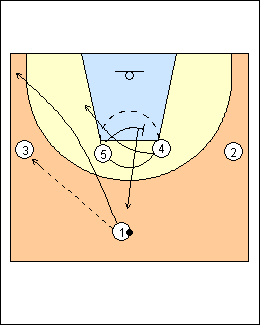 | 2 2005 entry 1 passes to 3 out of a 1-4 set and cuts to the strongside corner (he can cut weakside), 5 cross-screens for 4 then pops out top, they love to cross-screen the posts when they are high at the elbows. (Variation - 5 moves down to post, 4 comes high) |
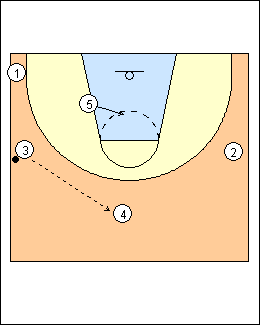 | 3 4 catches with an inside (right) pivot foot, but makes a cheat step outside with his left foot for balance, then forward pivots to face up. If you don't cheat step you will slow down and the defender can run through the pass. 4's options in order are shoot, dump inside (a two-hand pass from the forehead), reverse. Bigs post directly between the ball and the basket, making their defender decide how to play them, and opening up backdoor angles when the ball is at the top. You aren't going to score on the first side, so post strong, but don't fight it, let the defender go where he wants. |
 | 4 You want to reverse the ball, not pass it back. 2 has to get open on his own. If he is denied, it's an automatic backdoor, one bounce by 4, then backcut by 2 (the key is that 5 is posting in the middle of the lane). If there is no pass on the backdoor, 2 comes back out because X3 has to snap his head if he is overplaying. 2 has to get open. The high post always screens away after passing, so on ball reversal to 2, 3 and 4 stagger screen for 1, 3 gets behind the arc once 1 clears his screen (the rule for perimeter players when screening for other perimeter players), 4 slips and finds ball after screening for 1 (the rule for bigs when screening for a perimeter player). John Brady (LSU fast break) - a high post can follow his pass to ballscreen. 2005 - if defenders switch, probably 3 will act like he is screening, 1 acts like he is coming off the screen then pops back to replace himself, 4 screens for 3. Argentina flex (and Seth Greenberg slice offence) - 3 shuffle cuts using 5, 5 and 4 stagger screen for 1. |
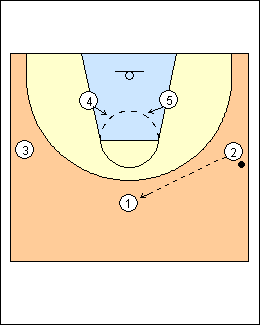 | 5 4 and 5 have to duck in with the ball at the sweet spot (out top), forcing their defenders to play high-side. |
 | 6 If the ball has been reversed once and a perimeter player catches it at the top, he has to go weakside after passing. |
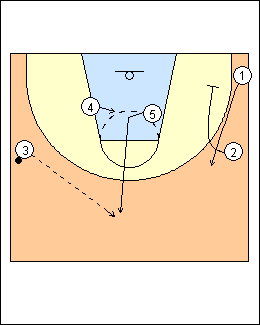 | 7 5 steps across his man and flashes high for a pass, 2 screens for 1 to get open (or 2 and 1 can interchange, 2 fake a screen for 1 and self replace, or 1 fadescreen for 2 then step to the ball), |
 | 8 4 follows the ball on a pass to 1. Now there is a ballside triangle (overload situation). There is no weakside help, 1 looks to throw the ball to the corner of the backboard for 4. 5 screens away after passing, 3 sets his man up, and will bump and fade, curl into the lane, or pop behind the arc if his man runs into the screen. |
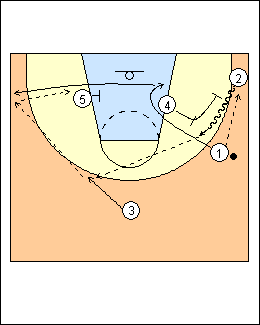 | 9 If 1 passes to 2 in the corner, 4 backscreens for 1, who button hooks back to the ball. 4 runs into a ballscreen (with a bad hedge by X4, who helped on the backscreen), he can roll or pop, 1 comes out weakside off a baseline screen from 5. Look for a kick to 3 then 1 and dump it low side into 5 with his defender on the high side. If 4 is a good post player, then he just stays and posts without screening for 1 (who exits weakside) or 2. See Georgia motion, Nets offence. |
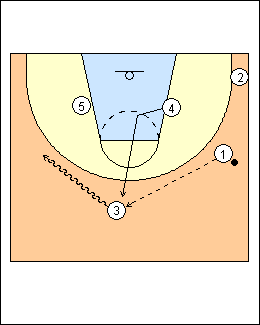 | 10 On a pass from 1 to 3 he takes one or two dribbles to improve his passing angle inside to 5, 1 gets high and wide. 4 steps across his man and flashes high (see the LSU fast break). If 3 passes inside to 5, 4 dives to the front of the rim, other players relocate to spot up on the perimeter. 5's looks are shot, his buddy 4, fan the ball to the other side, pass back where it came from. Bill Self (bbhighway.com) - a low post can chase any pass out to ballscreen. If the ball is reversed through 4, he would pass and screen away for 3. |
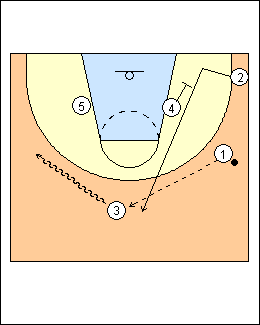 | 11 1999 variations When 3 dribbles over, 4 screens for 2, who walks his man down to the short corner. |
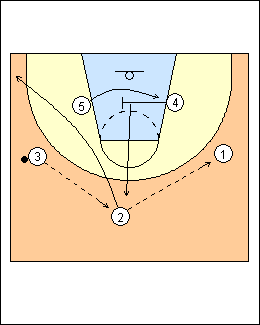 | 12 On ball reversal to 1, 2 cuts weakside, 4 cross-screens for 5, who goes under (better chance of a layup), then 4 comes high. Dennis Felton (Georgia) - have 4 cross-screen and come high to keep 5 close to the basket. |
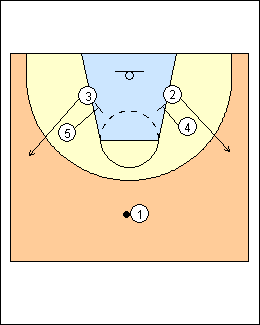 | 13 2) Entry pass to a high post (1-4 high) Against pressure. Start in an inverted stack with the guards on the blocks (or 4 and 5 start further out and downscreen, shown), 2 and 3 use screens to pop behind the arc. |
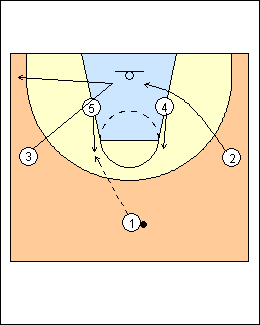 | 14 If 2 and 3 are denied, 4 and 5 flash to the elbows for a pass. To get a backdoor, 3 has to make his man believe he is going to get a pass, 5 catches the ball on the move (a bounce pass most of the time), and 3 has to be above ball level so his defender has to turn his head to see the ball. 3 steps across his defender (crossover step with his right foot) all the way to the lane then widens out to the ballside corner if there is no pass. 5 drop steps (reverse pivot on his inside (left) foot, looking to make a bounce pass with his outside (right) hand. At the same time 2 walks or trots his man into the lane, not too fast or his man will cover the backdoor. 2005 - 1 just passes to an elbow in a 1-4 set. |
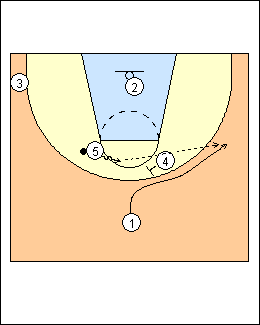 | 15 4 fade screens for 1, 5 takes one dribble and makes a two-hand overhead pass over the top to 1. |
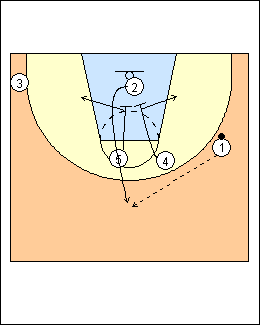 | 16 4 and 5 doublescreen for 2 then split, a pass to 2 out top gets into the high-low passing game, 4 and 5 duck in. If 1 drives baseline, X2 is the weakside helper, 2 will be wide open at the top. 2002 - 3 is high and wide. See the Colour quick hitter. |
 | 17 Houston (a special) Run pinch post, 1 passes to 5 and comes off for a hand-off. 2 stays high and wide, 5 and 4 double down for 3 then split into 3-out 2-in. |
 | 18 3) Dribble over If no one is open after stacking and breaking, 1 dribbles towards 3, who loops (zipper cut), 5 pins down then opens to post between the ball and the basket (if X5 shows on 3, look to get the ball inside, that happens a lot). |
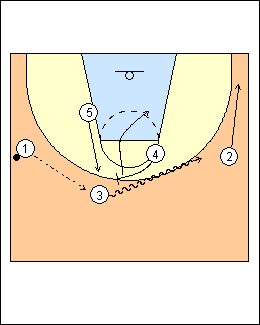 | 19 1 gets to the foul-line extended, 3 catches above the elbow so he has space to make a play, he will catch, rip and go with an outside-foot pivot (he doesn't catch, square and read). 4 ballscreens while the pass is in the air to force a bad hedge (X4 is a weakside defender, not yet in a position to hedge). 3 comes off the screen to shoot, drive, kick to 2, or, if defenders switch, drag the switch man to the point where there is a mismatch inside (mouse in the house). 4 rolls, 5 widens out one step off the lane then replaces, 2 adjusts, relocating where his man can't recover.. 2005 - 4 doesn't roll to the basket, he rolls to a point where he can keep X4 above him, creating space for a pass from 5 (shown). |
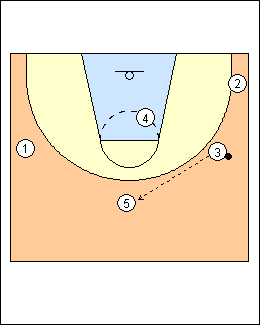 | 20 Then it's into the offence. Look for a hi-lo on a pass to 5 out top, on reversal to 1, 3 and 5 would stagger away. |
 | 21 2005 - for a pressure-release entry, 2 and 3 cross going half speed, 4 and 5 flash up once they clear. |
This page was made with Basketball playbook from Jes-Soft